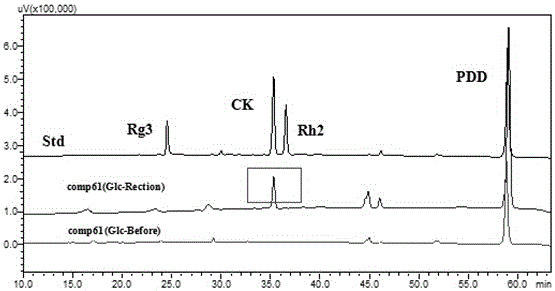Engineering bacteria of gynostemma pentaphylla glycosyl transferase, and construction method and applications thereof
A technology of glycosyltransferase and construction method, applied in the application field of the Gynostemma glycosyltransferase in synthesizing rare ginsenoside CK, can solve the problems of low yield, environmental pollution, complex ginsenoside process flow, etc. High, simple process, low consumption effect
- Summary
- Abstract
- Description
- Claims
- Application Information
AI Technical Summary
Problems solved by technology
Method used
Image
Examples
Embodiment 1
[0050] Cloning of Glycosyltransferase UGTGp3 from Gynostemma pentaphyllum
[0051] The glycosyltransferase genes that may catalyze the glycosylation of protopanaxadiol were screened with the help of search tools based on compounds and chemical reactions, combined with NCBI and other database resources, and plant PSPG boxes. Using primers SEQ ID NO.1-SEQ ID NO.2, and using a polymerase to amplify the gene from the Gynostemma cDNA library by PCR. The amplified fragment was gel-cut and purified, and double-digested with XhoI and BamHI. The digested fragment was ligated with the plasmid pET-28a (+) that had also been double-digested with XhoI and BamHI. The carrier: the target fragment Mix according to the molar ratio of 1:3, add T4 DNALigase, enzyme ligate at 22°C for 5 hours, and transform the ligated product E. coli DH5α, and positive clones were screened on the Kanna plate and verified by sequencing. The recombinant plasmid pET-28a(+)-comp61 was obtained.
Embodiment 2
[0053] Establishment of Escherichia coli expression strain and purification of Gynostemma glycosyltransferase UGTGp3
[0054] Transform recombinant expression plasmids into host bacteria E. coli BL21(DE3) (NEB Company) competent cells were used to obtain recombinant expression strains of Gynostemma glycosyltransferase. When the recombinant bacteria were cultured until the OD was 0.6-0.8, 0.1 mM IPTG was added, and the expression was induced at a low temperature of 16° C. for 20 h. The cells were collected by centrifugation at 5500 rpm at 4°C, and the cells were ultrasonically disrupted. It was purified using Ni-NTA His-binding resin.
Embodiment 3
[0056] in vitro enzyme experiment
[0057] According to the preparation of the in vitro reaction system, the experiment of glycosyltransferase was carried out.
[0058]
[0059] After incubating the reaction mixture for 3 h at 30° C., the same volume of n-butanol was added to terminate the reaction.
PUM
 Login to View More
Login to View More Abstract
Description
Claims
Application Information
 Login to View More
Login to View More - R&D Engineer
- R&D Manager
- IP Professional
- Industry Leading Data Capabilities
- Powerful AI technology
- Patent DNA Extraction
Browse by: Latest US Patents, China's latest patents, Technical Efficacy Thesaurus, Application Domain, Technology Topic, Popular Technical Reports.
© 2024 PatSnap. All rights reserved.Legal|Privacy policy|Modern Slavery Act Transparency Statement|Sitemap|About US| Contact US: help@patsnap.com










